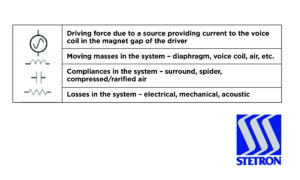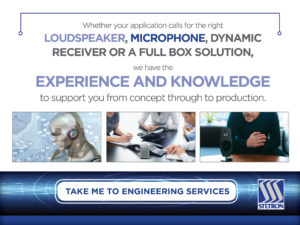How can we help you?
Thiele-Small Parameters: The Effect of Enclosures
- January 04, 2018
- Loudspeakers
Now that we have our TS parameters – and, more importantly, that highpass filter model we can generate from these – we can look at the effect of adding an enclosure around the driver. This comes down to adding components to the circuit representing the enclosure. But we have to remember that the electric circuit we’re using is an analogue for the conversion of the driving force of the loudspeaker system to the motion of air that produces sound. So, first we’ll review what these circuit symbols represent:

Closed Box
Now, the addition of a simple closed box as an enclosure can be represented by a compliance, CAB, due to the trapped air inside the box that must be compressed and rarified (“stretching” the air in the box). Just as the driver’s compliance can be expressed as the TS parameter, VAS, the enclosure volume determines CAB. Any energy losses in the enclosure, like air leakage, determine RAB in the circuit. 
All of those resistors represent losses in the system that reduce the efficiency of energy transfer from the driving source to the sound output. And the combination of masses and compliances determine the resonant frequency, f0, of the system.

Now, a well-designed enclosure should minimize the losses but the trapped air in the enclosure makes the overall compliance of the system stiffer than the compliance of the driver alone. A way to get a feel for this is stretching an elastic band and feeling how the elastic opposes this stretch. Now, add a second elastic band and the same amount of stretch requires a stronger pull. If compliance is the amount of stretch for a given force, the system with the driver and enclosure is less compliant than the driver alone. Point of fact: the system compliance is always less than the smallest compliance in the system. This results in a higher resonant frequency than the driver’s fS. And the smaller the enclosure the higher the new f0 of the system. This collection of frequency responses show the impact of enclosure size on resonant frequency.

That peak at resonance is the result of a reduction in the Q of the system due to the added enclosure.
Vented Box
A vented (aka ported) enclosure still has a volume of air in the cabinet that is compressed/rarified, reducing the overall compliance as we saw with the closed box. But the vent introduces a mass of air that now moves in and out as a result of the diaphragm motion. Just as the mass and compliance of the driver determine fS, this additional mass/compliance combination in the ported enclosure introduces a second resonance. Notice that the ported enclosure ignores any additional losses. Since the port provides an avenue for air to move in/out of the enclosure, leakage is minimal.
The “tuning” of this additional resonance is determined by the combination of enclosure volume and the volume of the air mass moving in the port. Notice, in this frequency response comparison, the additional “bump” in the frequency response, due to this second resonance, that extends the low frequency output of the speaker. Systems using a vented enclosure are often referred to as Bass Reflex systems due to the increased low frequency output. These systems tend to have a greater impact on the damping than a sealed enclosure. So, the Q of the system tends to be higher as evidenced by the increased peak at resonance.

The choice of sealed or vented enclosure – and the size of the enclosure (and port) – is determined by the cost/performance trade-offs like any audio engineering venture. An essential element of the design process is reliable TS data from the driver manufacturer. Stetron’s ability to provide reliable data and audio engineering expertise are a potent addition to any product development process where sound quality is an objective.
Have questions? Let us help. We are your source for audio solutions.
Email: contact@Stetron.com
Customer Service: Canada: 1-877-716-0751 U.S.A: 1-800-925-3002.

 Log In
Log In Register
Register Favorites
Favorites